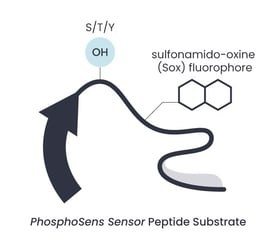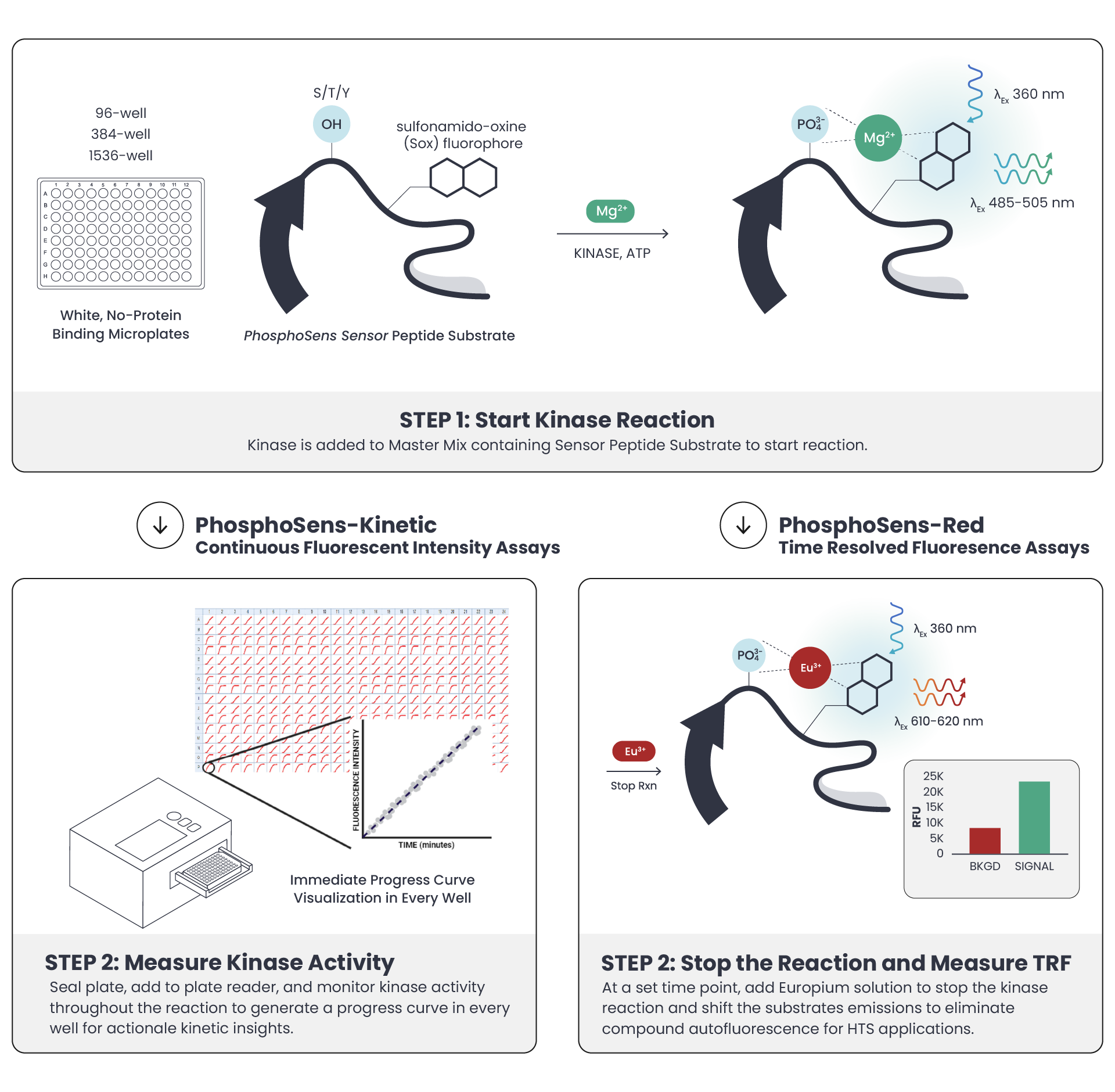Phosphosens® Technology
Discover the only technology that can directly measure real-time kinase and phosphatase activity in a simple add-and-read, direct, and continuous assay format.
A revolutionary approach to phosphorylation detection
Regulation and dysregulation of protein kinases and phosphatases is directly associated with hundreds of human diseases (cancer, immunological, neurological, cardiovascular, metabolic, and infectious). Specific and potent kinase inhibition in particular is key advance for patients and has fueled growth of drug discovery and development that integrates new technological breakthroughs.
Historically, the legacy assays for measuring kinase and phosphatase activity typically rely on indirect measurement (ATP consumption), are limited to a single timepoint, and do not mimic physiological conditions.
PhosphoSens technology was designed to enable simple, accurate, kinetic measurement of kinase and phosphatase activity over a variety of conditions in high throughput, enabling better decisions regarding target biology and generation and validation of lead candidates.
Advantages
Continuous
Measure initial reaction rates without assumptions of linearity, resulting in higher accuracy, precision, and improve understanding of your inhibitor’s mechanism of action.
Direct
Directly measure enzyme activity at the level of the peptide substrate, eliminating complications seen with indirect assays that require downstream coupled steps.
Physiologically Relevant
Leverage a range of conditions: from low levels of ATP (µM) to physiologically relevant ATP [mM], divalent cation concentrations (Mg2+, Mn2+, Ca2+), and substrate peptide sequences.
Streamlined Workflow
Save time with a simple add & read workflow. Reactions are initiated by adding enzyme or ATP, and a complete progress curve (time course) is captured with a standard microplate reader.
Powered by technology-packed sensor peptide substrates
Each peptide substrate is derived from an extensive library of >50,000 sequences and further optimized for target specific assay performance. Detection of phosphorylation occurs at the level of the peptide substrate in real time.
Covalently attached in close proximity to the Serine, Threonine, or Tyrosine phosphorylation site (± 2-5 residues) is the readout molecule: Sulfonamido-oxine (Sox).
The Sox fluorophore, developed by the Imperiali Lab at MIT, is uniquely designed for high performance in kinase assays. Its small size, comparable to that of tryptophan, minimizes steric hindrance. Additionally, the Sox fluorophore is neutral and minimally hydrophobic, reducing non-specific binding.
When phosphorylation occurs, magnesium (Mg²⁺), present at physiological levels and in large excess, interact with the Sox fluorophore and the newly added phosphate group on the phosphorylated amino acid. This interaction triggers fluorescence, providing a direct signal of the phosphorylation state of proximal serine, threonine, or tyrosine residues. This process, known as Chelation-Enhanced Fluorescence (ChEF), is directly proportional to the phosphorylation level, enabling real-time kinetic measurements.
The assay delivers a continuous signal, generating progress curves in every well, which offers unparalleled insights into enzymatic activity.

Typical fluorescence changes upon phosphorylation of a PhosphoSens Sensor Peptide Substrate. The fluorescence properties of the Mg2+coordinated with the 8-hydroxyquinoline of Sox has an λExMax of ~360 nm (358-363 nm) and λEmMax of ~492 nm (485-498 nm).
Simple workflow for continuous and red-shift formats

Identify and validate the right candidates faster with richer data
Applications:
- Kinome Profiling: Gain detailed kinetic insights into compound selectivity and mechanisms of action (MOA) by profiling against a comprehensive panel of over 400 wild-type kinases. Experiments can be conducted under physiological conditions with high or low ATP levels to match your research needs.
- IC₅₀ or Kᵢ Determination: Evaluate compound potency using 12-point dose-response curves. Flexible assay conditions include the presence of BSA or DTT, high or low ATP levels, and the ability to analyze protein complexes or crude lysates.
- kinact/Kᵢ for Time-Dependent Inhibition: Quantify covalent compound inhibition dynamics with 24-point time-dependent assays. These provide precise measurements of inactivation rates (kinact) and covalent binding affinities (Kᵢ).
- Residence Time: Characterize compound binding kinetics using the Jump Dilution method, with a detection range from 30 seconds to 48 hours. This service provides valuable data on compound dissociation rates for informed drug discovery.
- Mechanism of Action (MOA): Uncover how your compound interacts with kinases through detailed studies using ATP, peptide, or lipid substrates. Tailored to your target and research goals, MOA assays provide actionable insights.
- EC50: Assess compound potency for target activation with EC₅₀ measurements, delivering reliable data on dose-dependent activation to guide lead optimization.
Indications:
- Cancer: Exploring kinase-driven pathways, such as those involved in uncontrolled cell proliferation and survival, and metastasis.
- Neurological Disorders: Investigating signaling pathways regulated by kinases or phosphatases including Parkinson’s Disease, stroke, and various tauopathies such as Alzheimer's disease (AD), frontotemporal dementia, corticobasal degeneration (CBD), and chronic traumatic encephalopathy, characterized pathologically by the deposition in the brain of aggregates of the insoluble hyperphosphorylated form of the tau protein (p-tau).
- Cardiovascular Diseases: Studying kinases or phosphatases that affect heart function, blood vessel regulation, cardiac hypertrophy, myocardial infarction and hypertension.
- Immunology: Evaluating kinases or phosphatases involved in immune cell activation, chronic inflammation, and autoimmune diseases where signaling is deregulated.
- Metabolic Disorders: Characterize kinases or phosphatases implicated in diabetes, insulin resistance, obesity, dyslipidemia, and metabolic dysfunction-associated fatty liver disease (MAFLD).
Stay Informed
Want to hear the latest about our technology? Be among the first to learn about our latest products and services.